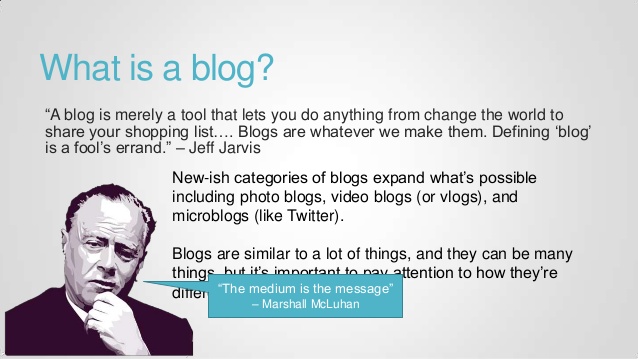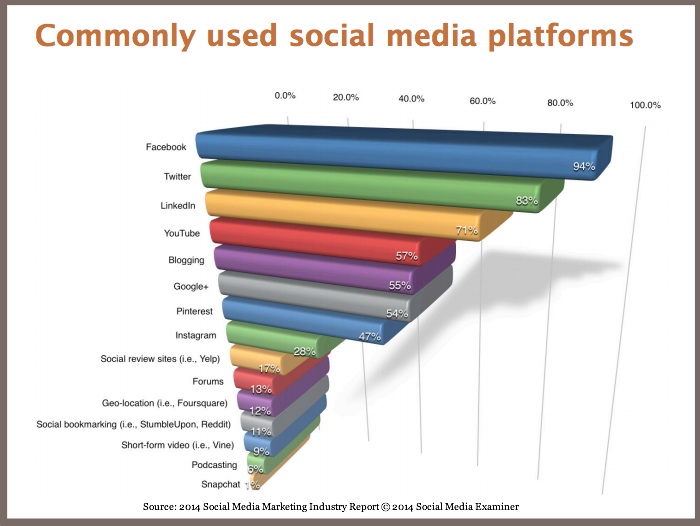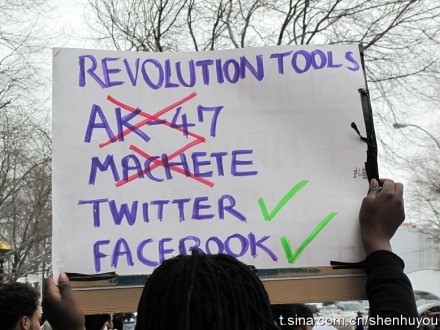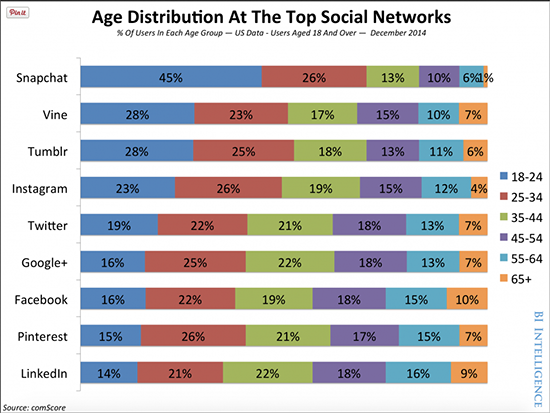Exactly what IS a blog, anyway?

I am midway through teaching a Technical Writing class online for Lane Community College using Edublogs. As I make my way through posts and comments by students, I find a lot of misconceptions about blogs. One big one seems to be that blogging has to do with age. A fifty-year old woman said she thought she was past the age of blogging; a younger student replied that she thought blogging was for older folks and college students didn’t blog.
Uh. Um. That’s like saying a publication platform like newspapers or books have to do with age. No. They are just a platform, a method, a way to do something. The words themselves don’t imply the age of the users.
Do you use Facebook? Twitter? Tumblr? Snapchat? Those are called “micro-blogging” sites (I linked that to Wikipedia, so you can see the full definition if this is news to you.)
“The most active demographic group for blogging is 21-to-35 year olds with 53.3% of the total blogging population.” (Source: Sysomos)

All major online newspapers such as cnn.com, the huffingtonpost.com, even the Oregonian are all blogging platforms. It has nothing to do with age and everything to do with a method of getting material online for the world to see.
“Twitter’s audience is younger with 22.6 percent of its 52.9 million users between 18 and 24 years. Its overall audience is expected to rise to 57.3 percent in 2016. Another 21.5 percent is between 25 and 34 years old.” (Source: Central Valley Business Journal)
Microblogging services such as Twitter are also used within socio-political revolutions–ever heard of Arab Spring? Need more examples?

Twitter has played a key role during a wide range of social movements: (Source: Buettner & Buettner
- 2007 WikiLeaks,
- 2009 Moldova,
- 2009 Austria student protest,
- 2009 Israel-Gaza,
- 2009 Iran green revolution,
- 2009 Toronto G20,
- 2010 Venezuela,
- 2010 Germany Stuttgart21,
- 2011 Egypt,
- 2011 England,
- 2011 US Occupy movement,
- 2011 Spain Indignados,
- 2011 Greece Aganaktismenoi movements,
- 2011 Italy,
- 2011 Wisconsin labor protests,
- 2012 Israel Hamas,
- 2013 Brazil Vinegar,
- 2013 Turkey).
Microblogging has also emerged as an important source of real-time news updates during socio-political revolutions and crisis situations, such as the Mumbai terror attacks or Iran protests.The short nature of updates allow users to post news items quickly, reaching its audience in seconds.
Business Blogging Facts & Stats That Should Not Be Ignored
Why do we learn to use online blogging software in a Technical Writing class?
- Because technical writing has a lot to do with making technical content appealing to readers.
- That means organizing the material using a superstructure.
- But the superstructure is not just an intellectual tool for organizing content, it is also VISUAL. It is an element of page design.
- Including images and learning how to caption and attribute sources are all also both technical in creating the charts and visual in laying them out to be visually attractive to the reader.

Considering How Much Grief Students Give Me About Learning to Blog, Even Though They Learn to Do It So Well, Why Do I Continue to Ask Them to Blog?
Because I believe in freedom of the press.
I believe every individual should have a voice and a means to let that voice be heard.
I don’t care if they never use the technical writing material, but I DO care that they realize that right now the world wide web is still open and free. And that is incredibly important to know because it doesn’t have to stay that way. You betcherlife the multi-national mega corporations want to eat it alive and control every possible entryway.


Erin,
Thanks so much for being a good sport and also for inspiring me to write this post!
Sandy
You keep teaching me, Sandy- and I live to learn from you…
Sandy, Thanks for your article and facts.. It has really opened my eyes. Blogging is a broader term than I first realized. I thought of blogging as personal “diaries” to those that seek your information. Wow, was I wrong. If I were to take nothing from this class other than learning the vast use for a blog then I have gained so much. I am getting a little more comfortable with each project you have us work on. I really am excited to see how I will begin to interact with my own website blog after this class. I will let go of the “age” thing, I seemed to have had. Thank you for educating me in the art of “Blogging” as a means of information and writing. I feel enlightened. Thank you!
Thanks for your thoughtful comment!
Even to me (born in 1950), blogs seem like they’ve been around awhile–after all, they actual word “weblog” was born in 1997, the same year a lot of my younger students were born. However, the technology has exploded and a huge percentage of what were once called “websites”now include a blog.
What is the difference?
The issue is whether people truly understand the difference between a website and a blog. They certainly are not the same thing.
The basic differences between a blog and a website are:
Website
Content is static.
Formal/professional.
Interactivity does not exist. There is only one-way communication.
Transactional.
Communication about products and/or services.
Almost everyone has a website. In fact, it is almost a requirement in business today.
Blog
Content is regularly updated.
Not formal.
Interactive.
Informative and educational.
Interactivity about industry/customer issues.
Almost every website also has a blog.
You are right that blogs continue the word-of-mouth and epistolary (letter-writing) traditions but on steroids.
On your last point: thanks for noticing the layout of this post. I really tried to trick it out, so students could see how to cite sources and different ways of drawing the eye down the page while still conveying information.
🙂
Sandy,
I really enjoyed this post. I especially liked the fictitious block quote where you “schooled” Johnny. I think part of the misconception comes from the “newness” of blogging. However, just because it didn’t look like what it does now, I would argue that blogging has been around a long time. If you think of it as its simplest form, a place to regurgitate information for people to discuss and comment on, then I would say that even letter correspondence between colleague and friends back in the day could be classified as a type of brick and mortar blog. While I don’t tend to attach an age to blog, one area of my life that I recently had my eyes opened was in the world of gaming. A common thing in the gaming circles to do, is to record yourself playing a game. Live-blogging of sorts, and I came across a live blog by an 86 year old women. She commented and interacted with her fans. She had said that the whole reason she started her channel was to show people that game weren’t just for kids. She’d started playing as something to do with her grandson, and loved it so much. It hadn’t even dawned on me that video games could be THAT universal. I’ve definitely made sure to try, since then, to not assume people of a certain age don’t use a specific technology just because it doesn’t seem like they would. I would also just like to mention, that seeing the format of this blog post as inspired me to really play around with my posts.